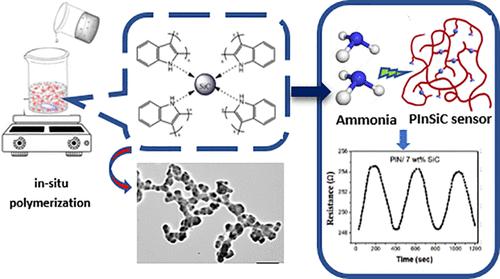Our official English website, www.x-mol.net, welcomes your feedback! (Note: you will need to create a separate account there.)
Development of High-Performance Polyindole/Silicon Carbide Nanocomposites for Optoelectrical and Sensing Applications
Langmuir ( IF 3.9 ) Pub Date : 2024-04-08 , DOI: 10.1021/acs.langmuir.3c04001 R. Gopika 1 , K. Arun 1 , M. T. Ramesan 1
Langmuir ( IF 3.9 ) Pub Date : 2024-04-08 , DOI: 10.1021/acs.langmuir.3c04001 R. Gopika 1 , K. Arun 1 , M. T. Ramesan 1
Affiliation

|
In this study, silicon carbide (SiC)-reinforced polyindole (PIn) nanocomposites were prepared by a simple in situ polymerization method. The successful reinforcement of the nanofiller within the host matrix was characterized using different analytical techniques. The chemical bonding of SiC in the polymer was identified by the characteristic peak around 800 cm1 using Fourier transform infrared spectroscopy (FT-IR). The increment in intensity of the absorption and enhanced crystallinity of the samples upon the addition of nanofillers were analyzed using UV–vis spectroscopy and X-ray diffraction (XRD). The prepared specimens showed reduced optical bandgap energy (3.188 eV) and Urbach energy (2.315 meV) with an improved refractive index (2.348). The effect of nanoparticles on the surface morphology of the nanocomposites was studied using scanning electron microscopy (SEM), and a uniform dispersion of fillers in the matrix was found for PInSiC7. A high-resolution transmission electron microscopy (HR-TEM) revealed the shape and average particle size of the sample. X-ray electron spectroscopy (XPS) measurements confirmed the formation of the nanocomposite by exhibiting the presence of all elements in the corresponding spectra. The thermal stability and glass transition temperature of the nanocomposites were significantly improved with the addition of SiC. The temperature-dependent AC conductivity, dielectric parameters, complex impedance, and electrical modulus were also evaluated using an impedance analyzer. The increased electrical characteristics of the PInSiC7 sample can be attributed to the uniform spread and strong synergetic interaction of SiC with PIn. The results thus showcased the potential of the samples for use in optical and energy storage applications. This study was also extended to understand the ammonia sensing properties, which make it possible to design and develop gas sensors using the PInSiC nanocomposites.
中文翻译:

用于光电和传感应用的高性能聚吲哚/碳化硅纳米复合材料的开发
在这项研究中,通过简单的原位聚合方法制备了碳化硅(SiC)增强的聚吲哚(PIn)纳米复合材料。使用不同的分析技术对主体基质内纳米填料的成功增强进行了表征。使用傅里叶变换红外光谱(FT-IR)通过800cm 1附近的特征峰来识别聚合物中SiC的化学键。使用紫外可见光谱和 X 射线衍射 (XRD) 分析了添加纳米填料后样品吸收强度的增加和结晶度的增强。制备的样品显示光学带隙能量(3.188 eV)和乌尔巴赫能量(2.315 meV)降低,折射率提高(2.348)。使用扫描电子显微镜(SEM)研究了纳米颗粒对纳米复合材料表面形貌的影响,发现 PInSiC7 填料在基体中均匀分散。高分辨率透射电子显微镜(HR-TEM)揭示了样品的形状和平均粒径。 X 射线电子能谱 (XPS) 测量通过显示相应光谱中所有元素的存在证实了纳米复合材料的形成。 SiC的添加显着提高了纳米复合材料的热稳定性和玻璃化转变温度。还使用阻抗分析仪评估了与温度相关的交流电导率、介电参数、复阻抗和电模量。 PInSiC7 样品电特性的增强可归因于 SiC 与 PIn 的均匀分布和强烈的协同相互作用。因此,结果展示了样品在光学和能量存储应用中的潜力。这项研究还扩展到了解氨传感特性,这使得使用 PInSiC 纳米复合材料设计和开发气体传感器成为可能。
更新日期:2024-04-08
中文翻译:

用于光电和传感应用的高性能聚吲哚/碳化硅纳米复合材料的开发
在这项研究中,通过简单的原位聚合方法制备了碳化硅(SiC)增强的聚吲哚(PIn)纳米复合材料。使用不同的分析技术对主体基质内纳米填料的成功增强进行了表征。使用傅里叶变换红外光谱(FT-IR)通过800cm 1附近的特征峰来识别聚合物中SiC的化学键。使用紫外可见光谱和 X 射线衍射 (XRD) 分析了添加纳米填料后样品吸收强度的增加和结晶度的增强。制备的样品显示光学带隙能量(3.188 eV)和乌尔巴赫能量(2.315 meV)降低,折射率提高(2.348)。使用扫描电子显微镜(SEM)研究了纳米颗粒对纳米复合材料表面形貌的影响,发现 PInSiC7 填料在基体中均匀分散。高分辨率透射电子显微镜(HR-TEM)揭示了样品的形状和平均粒径。 X 射线电子能谱 (XPS) 测量通过显示相应光谱中所有元素的存在证实了纳米复合材料的形成。 SiC的添加显着提高了纳米复合材料的热稳定性和玻璃化转变温度。还使用阻抗分析仪评估了与温度相关的交流电导率、介电参数、复阻抗和电模量。 PInSiC7 样品电特性的增强可归因于 SiC 与 PIn 的均匀分布和强烈的协同相互作用。因此,结果展示了样品在光学和能量存储应用中的潜力。这项研究还扩展到了解氨传感特性,这使得使用 PInSiC 纳米复合材料设计和开发气体传感器成为可能。



























 京公网安备 11010802027423号
京公网安备 11010802027423号